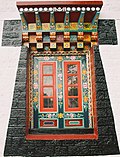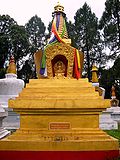| Northeast India | |
|---|---|
 States and big cities in Northeast India | |
| Population Census Estimate (2022) | 51,670,000 |
| Area | 262,230 km2 (101,250 sq mi) |
| Time zone | IST (UTC+5:30) |
Northeast India consists of eight states: Arunachal Pradesh, Assam, Manipur, Meghalaya, Mizoram, Nagaland, Sikkim and Tripura. Tourism in this area is based around the unique Himalayan landscape and culture distinct from the rest of India.
Contents
- Tourist circuits
- National parks
- Reserved forest
- Hills
- Hill stations
- Waterfalls
- Lakes
- Lake islands and islets
- River islands
- Monasteries
- Ancient Hindu sites
- Temples
- Forts and Palaces
- World war memorial sites
- Monuments and other tourist spots
- Living root bridges
- Madan Kamdev
- Meghalaya caves
- Capital cities
- Agartala
- Aizawl
- Gangtok
- Guwahati
- Imphal
- Itanagar
- Kohima
- Shillong
- See also
- References
- Official websites




































































